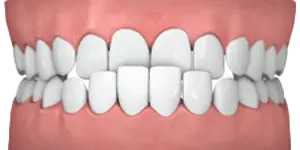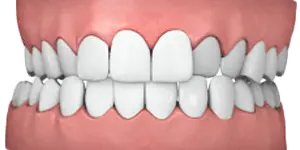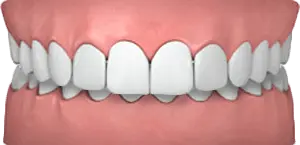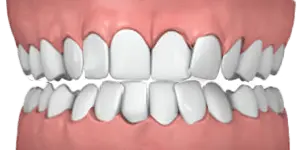The Typical Culprits
As orthodontists, we specialize in treating malocclusions, or bad bites. That’s doctor-speak for when your teeth or jaws don’t fit together correctly. Orthodontic treatment is usually necessary to straighten the teeth and stabilize the bite for ideal function. While malocclusion can make you feel self-conscious about your smile’s appearance, it can also cause problems with speaking and chewing, premature wear of the teeth and enamel, changes in your facial structure and increase the chances of injury to the teeth and jaw joints if left untreated. While everyone’s mouth is unique, these are the most common issues we see in our office:

Underbite
In an underbite, the lower jaw extends out past the upper jaw, causing the lower front teeth to sit in front of the upper front teeth. This is one of the problems that’s best treated early since it can cause sleep apnea and difficulties chewing and speaking. Early intervention also helps patients avoid corrective jaw surgery.
Treatment: If the patient is still growing, we can use appliances to advance the upper teeth and jaw followed by a round of braces or Invisalign. If you wait until adulthood to deal with it, corrective jaw surgery combined with orthodontic treatment may be the only way to get stable, dramatic results.

Crossbite
A crossbite is characterized by upper teeth that sit inside the lower teeth. It can occur in the back of the mouth (posterior crossbite) or the front of the mouth (anterior crossbite). Since patients usually compensate by moving their jaw forward or to the side, it can permanently change the structure of the face.
Treatment: Anterior crossbites typically respond well to braces or Invisalign. Posterior crossbites may require Dr. Yoo to expand the upper jaw in combination with braces or Invisalign.

Upper Front Teeth Protrusion
This is a fancy way of saying your upper front teeth stick out because they’re extended too far forward or the lower teeth aren’t extended far enough forward. The appearance and function of your teeth are impacted and they’re extremely susceptible to injury.
Treatment: We can shift your teeth into place with braces or Invisalign.

Overbite
An overbite occurs when the upper front teeth extend out over the lower front teeth. Overbites can cause excessive wear of the enamel and make the top teeth more prone to being knocked out or damaged.
Treatment: For overbites that are mild or moderate, and not due to a skeletal issue, braces or Invisalign will do the job. Severe overbites might require appliances to move the jaw along with braces or Invisalign.

Crowding
When the teeth don’t have enough room to erupt, they come in at odd angles and can overlap or protrude. This makes them harder to clean, which can lead to tooth decay.
Treatment: We try to avoid extractions unless it’s the absolute last resort. In some cases, braces or Invisalign alone will remedy the problem. Other times, it might be necessary to use appliances to expand the jaw when the patient is younger so the teeth will fit correctly.

Spacing
Spacing occurs when the jaw is too roomy and the teeth just can’t fill the space. It leaves gaps between them. It can be simply a cosmetic issue or due to missing teeth. Spacing is associated with bone loss and gum disease.
Treatment: More often than not, braces and Invisalign will treat spacing. If orthodontic treatment alone can’t close the gaps, veneers are an option to build up the teeth.
Contact Info
Current Patient: 650-327-2310
New Patient: 650-844-0638
Email: smile@paloaltoorthodontics.com
Fax: 650-999-0710
Address:
454 Forest Avenue
Palo Alto, CA 94301
Hours:
Monday-Thursday: 8:00 a.m. – 5:00 p.m.
Friday: By appointment only


